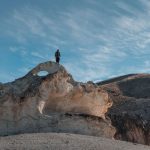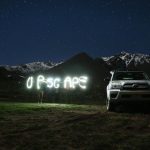Tips from a Chilean Astronomer
Astronomer and friend to Upscape José Miguel Fernández Contreras remembers clearly what first attracted his attention to space. In 1986, he was five years old when Halley’s Comet crossed the Earth’s path, turning all eyes skyward to witness the spectacle. Years later, when he was deciding what to study in college, he found himself interested in the physics of these faraway objects, and gravitated towards astronomy. Even then, he was fascinated by what he calls “one of the paradoxes of astronomy,” that information is collected via light, radio waves, X-rays and gamma rays, all measured from a distance. “The problem, and what defines astronomy in many ways is that we can’t generally touch the subject we study.”
And in the case of the work he does at ALMA, the Atacama Large Millimeter/submillimeter Array in the north of Chile, near San Pedro de Atacama, they can’t touch their subjects, and they can’t precisely see them either. The 66 radio telescopes here can be used as a single array or to study different phenomena in the sky, but not in the way you might think of observatories as functioning. Because they are not optical telescopes, they can scan the sky day or night. The telescopes collect data on waves, and that data is sent to a powerful computer called a “correlator,” and from there, usable information is sent to the science entities that requested it.
Even though ALMA is not a visual telescope field, many of the main conditions that make the Atacama desert an ideal spot for so many observatories—which stretch northwards from the Elqui Valley (where the next full solar eclipse will be visible in July 2019) up to near San Pedro de Atacama, where ALMA is—apply here as well. Astronomers require an area with little interference, in the form of light for optical telescopes, and for radio telescopes, with as little satellite interference as possible. The delicate sensors can be damaged by strong signals, like those for telecommunications. And in both cases, skies with as little water vapor as possible are ideal.
The Atacama, as the driest non-polar desert in the world, is a good bet. José describes it as an investment, where you want the best possible returns. The best returns for astronomy are being able to use the precision instruments for as many hours a day as possible, in as perfect conditions as possible. It’s incredibly expensive to build an array like ALMA, which is a partnership between the United States, Canada, Japan, South Korea, Taiwan and Chile. It cost $1.4 billion to construct, and is the world’s most expensive ground-based telescope currently in operation. ALMA has been collecting data on the cosmos since 2013.
Much of what ALMA observes is directed by research requests from partner countries. Some of what it observes is about extremely slow phenomena, such as star formation. This process cannot be observed in real time, nor can scientists look at how a single star is formed, because of how slow the process is, and the short period of time that they’ve been collecting data. Instead, astronomers can observe short radio waves that indicate for example, a very cold cloud of gas, believed to be the precursor to star formation. In another location in space, they may glean data about this type of cold cloud collapsing upon itself, which astronomers believe to be a later stage of star formation. This pressure causes the temperatures to rise, in yet another stage by which stars are born from an area referred to as a “stellar nursery.” Ultimately, star formation is a process that can take many thousands of years to complete, and ALMA, as well as other observatories, collect data on those different phases in different parts of space at different times to put together what we know in this case, about the birth of a star. Star formation just happens to be one of José’s interests, and something he gets to participate in collecting data about, as part of the Science Operations team at ALMA.
José has visited observatories in the US, Europe and Chile, and run tours at some of them as well. He says there are two main things observatory visitors want when they visit: to see the operations, which in the case of ALMA are the 12- and 7-meter diameter radio telescopes and the control room at base camp; and to look through a telescope. Looking through a powerful telescope is fascinating for visitors, he says. You can point the telescope at what he refers to as “a few awesome objects,” like Saturn, the craters of the moon, and people feel like they got what they came for.
But while he agrees that looking through a telescope gives people a great view of a single slice of the sky, he feels the context of the wonder of seeing the whole sky
is easily lost. He likens it to going to the nearby town of San Pedro de Atacama—a popular jumping off point for getting to know the desert, oases and geysers of the region—and looking only through a small window, to see, for example the peak of Volcán Lincancabur, or just a tiny piece of a salt flat.
To help visitors orient themselves, and learn something, rather than just see something, José likes to take a bit of a teach-a-man-to-fish approach for interested visitors. The movement of the sky, and the appearance and disappearance of stars over the horizons are things that visitors can easily be shown, he says, and that they can take with them to whatever night sky they happen to gaze upon in the future, so long as it is free of light pollution.
To really get a complete picture of the sky, José’s dream tour would teach people to read a sky chart, ideally paper, as he says the app on phones and tablets is too bright, and makes it harder to see the sky afterwards. Using a red light on paper preserves the eye’s sensitivity. After teaching visitors to read the star chart, he’d have them notice the perceived motion of the stars across the sky.
The sky appears to be in constant, slow motion, due to the rotation of the earth. José suggests thinking about the speed in terms of the sunset, how long it takes from the time the sun hits the horizon, a mountain or the ocean, until it is gone completely from view. In that time lapse, the earth has rotated enough to make objects in the sky appear to have moved that distance. Venus, for example, which is usually only visible for a short time before dawn and after sunset, will disappear over the horizon over the course of minutes if you keep a close eye on it.
In the southern hemisphere, the sky appears to rotate around an imaginary point called the southern celestial pole in a clockwise fashion, whereas in the northern hemisphere, it looks like it’s going the other way around the northern celestial pole. The difference in rotation, José says can briefly disorient sky watchers when they’re in the opposite hemisphere from where they are used to seeing the sky, like east coasters may confuse north and south when standing at the shores of the Pacific, rather than the Atlantic Ocean.
After first teaching people how to use their naked eye to observe the sky, and a chart to identify what they’re looking at, only then would José add in binoculars or a telescope. He’s not anti-magnification, he just thinks there’s so much more to see when there’s not much (or anything) between your eye and what you’re looking at. But “once you learn how to read the sky in a very basic way, and understand how it moves, you get a better sense of orientation, you can turn your head around, and come back, and know that you’re seeing the same star.” After visitors learn to read the sky, like as children we learn to read maps, they can describe to other people what they are looking at. Pointing to objects in the sky is made much easier when you use their names saying, there’s Antaris or Sirius, or after finding the constellation Orion, locating the star Betelgeuse, for example. Constellations are in different parts of the sky at different times of the night and the year, and José says astronomers and night sky watchers like him are as aware of their locations as you or I might be of what fruit is in season in the place we live.
Another thing astronomers keep on their calendars even years in advance are the coming total solar eclipses. José says that after a lifetime of observing the sky looking at slow changes, he’s “eager” to see the upcoming total solar eclipse that will take place in Chile’s Elqui Valley on July 2, 2019. “If you think about it,” he says, “for most people who don’t get to travel, they could spend a lifetime, or even generations could pass without a total solar eclipse happening where they are.” It makes perfect sense to him that there are eclipse chasers who fly around the world, to Easter Island, to Africa, who take cruises to the middle of the ocean, take flights that follow the shadow of the moon just to experience an eclipse. So much of what happens in life he describes as something that you can “see today, or see tomorrow,” but eclipses wait for no one.
And here José goes low-tech again, talking about the eclipse. Of course, he says, you use your solar eclipse glasses before and after totality, to protect your eyes. “But during totality, the time when the sun is fully blocked out by the moon, for that minute or two, you can take your glasses off, and observe the external structures of the sun, called the corona, with the naked eye.” When José goes to Elqui to see his first solar eclipse, he also plans not to pick up his camera during totality, and says you might want to do the same, unless you’re a professional photographer committed to getting that perfect shot. “For most people, putting a camera [in front of your eye], and losing 10 to 20 seconds out of how many, of 60 seconds? It’s crazy,” he says. He encourages people to experience this unusual natural display completely, to lose themselves in nature for just that short period of time.
As José and I wrap up our conversation, winter twilight is approaching, and he’s in one of the world’s most perfect places to take a look. Even after all these years, he still trains his gaze to the heavens at night when he gets the chance. “Having these conversations always reminds me of the things I love to do. Out there in a couple of hours, it’s going to be dark, and the night sky is going to be beautiful.” Surrounded by some of the most advanced technology in the world, he says that tonight he’s “going to just put on a warm jacket, go outside and look up.”

